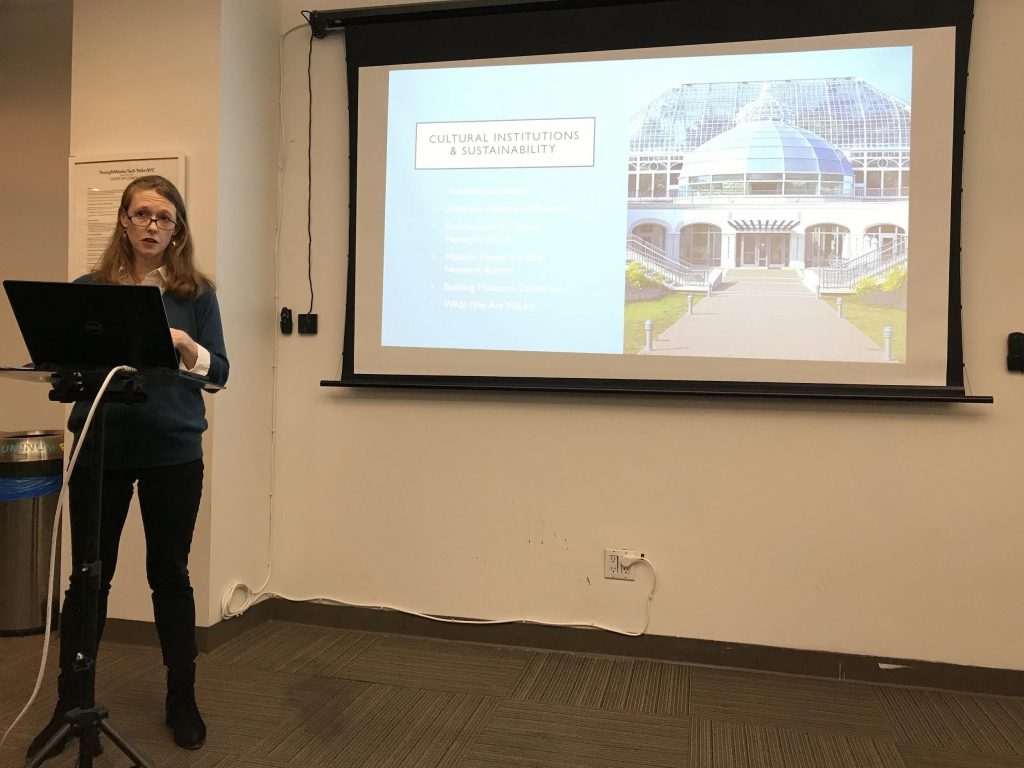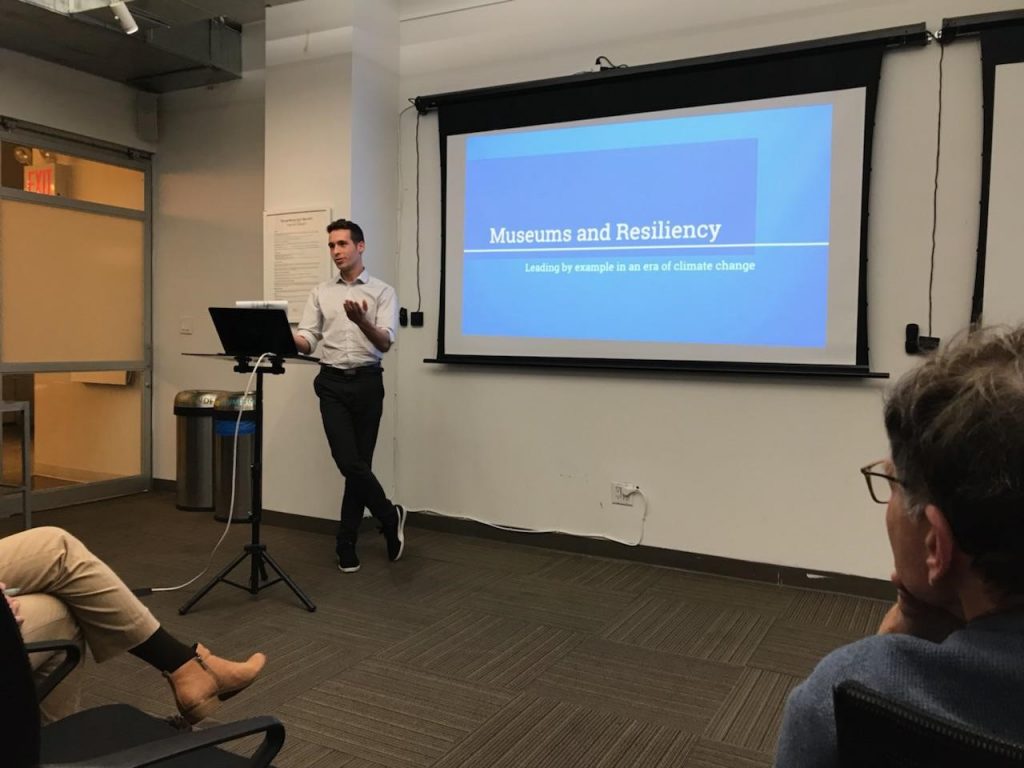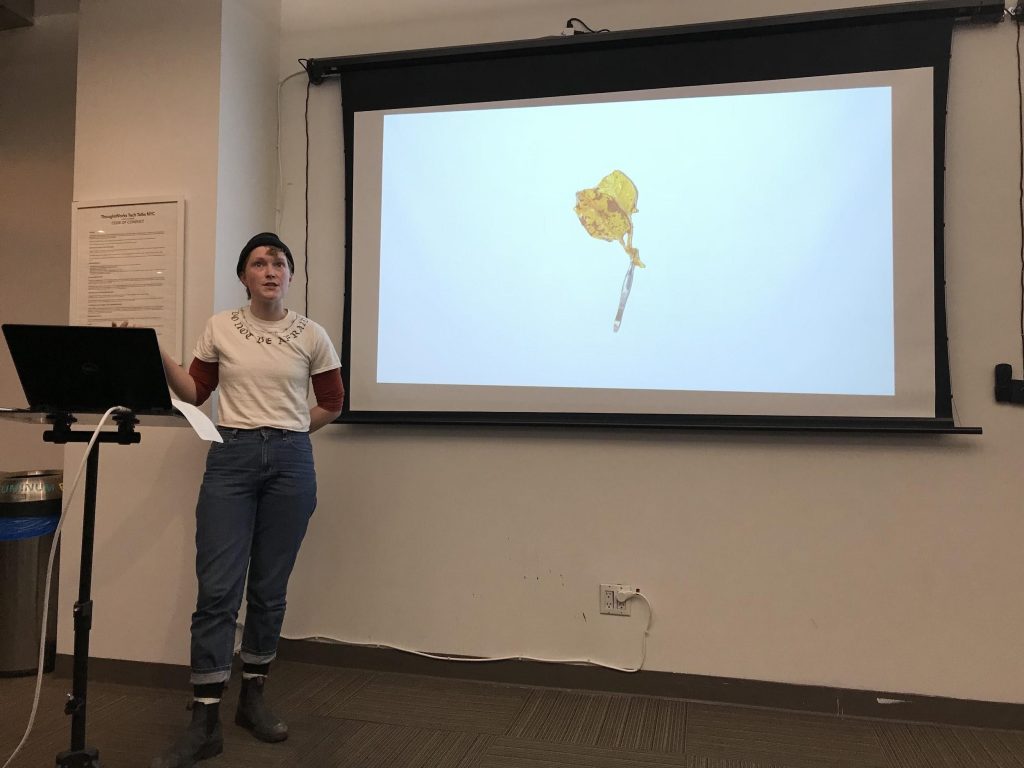by Stanley M. Kaminsky
At GreenHomeNYC’s November Forum, four speakers who specialize in the intersection of art and sustainability came together in ThoughtWorks’ Manhattan office to speak about their work. The panelists, who have differing backgrounds within art and sustainability, provided the audience with a diverse conversation ranging from environmentally-friendly museum buildings to artwork that communicates the urgency of climate change.
Environmentally-Friendly and Disaster-Ready Museums

Sharon Gaber serves as manager at North American Passive House Network, but focused her presentation primarily on her other professional role – development chair for the Environment and Climate Network (ECN) within the American Alliance of Museums. Specifically, the ECN is a community that aims to establish museums and other cultural institutions as leaders in the world of sustainability and climate action. They carry out their mission by providing a multitude of resources to museums seeking to implement sustainability within their facilities. They also bestow Sustainability Excellence Awards on museums and cultural institutions that stand out as true sustainability and climate action leaders.
Gaber highlighted one particular winner of the ECN’s Sustainability Excellence Award – the Missouri Historical Society in St. Louis. The Society puts sustainable practices high on their priority list, such as reducing their energy consumption and waste. The Society commissioned an external organization to study its energy consumption and provide advice on how to run more efficiently. This led to a complete lighting upgrade in both the Society’s library and research center. The restaurant within the museum now also adheres to environmentally-friendly practices.
Gaber wisely emphasized that, in addition to helping the planet, there’s another important pay-off to museums going green: empowering visitors to adopt their own environmentally-friendly behaviors. Museums are vehicles to educate and empower their communities. When places like the Missouri Historical Society adopt the ECN’s green values, they empower visitors to do their part in helping the environment as members of the community.

The next speaker was Raphaël Gernath, who specializes in sustainable and inclusive planning for urban buildings. Similar to Gaber, his focus was on museums, but instead of discussing opportunities for going green, Gernath focused primarily on global case studies of museums that have implemented disaster-ready architecture, allowing them to sustain themselves in the face of weather disasters like floods and wildfires. One of the case studies that Gernath presented was the Louvre Museum in Paris, home to Da Vinci’s Mona Lisa.
One of the Louvre’s challenges is its location directly next to the River Seine. Throughout history, the Seine has flooded multiple times, causing damage to the Louvre and its artwork. In response, architects and other planners have developed architectural strategies to protect the museum and its pieces from further climate-inflicted damage.
For example, the Louvre planned a new facility in northern France in the town of Liévin, where all of the artwork will be relocated in the face of another severe flood. The team responsible for relocating the art is 500-strong. In addition, the Louvre updated its infrastructure at home base. Four large pumping stations are now in place underneath the museum to help direct flood waters to sewers, and large steel doors are also situated in the museum’s basement to deter floodwaters from rising into the facility. Thus, should the Seine flood again, the Louvre is prepared.
Gernath presented several other case studies of museums that are similarly putting protective measures in place to ensure resiliency. Those case studies included the Whitney in New York, the Dalí Museum in St. Petersburg, the MAPR in Puerto Rico, and the Getty Museum in Los Angeles.
Sustainable Artwork and Communicating Climate Change

The next speaker was Philadelphia-based artist Em Rea, whose artwork largely explores the history of particular places through the use of sustainable and often biodegradable materials. One of the installations that Rea presented to the audience is called “Redshift.”
Rea created“Redshift” while in a residency program in northeast Philadelphia called Recycled Artists in Residency (or RAIR). Rea was fascinated by the MetalBank Superfund Site on the RAIR property. Years ago, the Metal Bank Superfund Site was home to a facility that recycled batteries. That facility leaked PCB pollutants into the local water supply and harmed the nearby environment. Rea decided the wreckage left behind from the old facility would be the ideal place to tell a story about the location’s history.
Using red lights, Rea directed the light beams within the wreckage at natural materials, like spiderwebs and plant life that is reclaiming the land. The result of the juxtaposition of nature within the facility’s wreckage is a profound story that acknowledges the harm the recycling facility caused to the environment, but also the rehabilitation that nature is now providing by reclaiming that space. The entire installation is created with sustainable media, including minimally-invasive red lights, and the natural elements that have gathered there over time.

The final speaker was Andrew McWilliams, artist, technologist, director of Thoughtworks Arts, and founding member of ClimateAction.tech. McWilliams started his discussion with a brief history of his beginnings as an artist, showing pictures and videos of his early installations, including one entitled “Gravity,” that implemented projections onto canvas.
It wasn’t until McWilliams was diagnosed with Type 1 diabetes that his work started linking the urgency of emergency healthcare with the urgency of climate change. While dealing with his diagnosis, McWilliams was involved in global warming advocacy efforts and witnessed some of the world’s political leaders willingly ignore the reality of climate change.
McWilliams realized that with his diabetes diagnosis, and political leaders discrediting climate change science, the stakes in his life were higher than ever. He began thinking that climate change is similar to a Type 1 diabetes diagnosis in that early treatment and lifestyle change is essential to avoid catastrophic outcomes.
In response, McWilliams created an art installation entitled “Emergency Room” in 2016. The work filled a red-lit gallery space with several flickering and rapidly changing video displays of disastrous weather events, and activists and people describing the effects they are already witnessing. Audio speakers filled the space with the constant noise of a person breathing heavily. Amidst this chaos, a single video monitor displaying an EKG beeps ominously. The cumulative effect of these elements in the installation is a communication of the urgency of climate change through the lens of a personal medical crisis.
